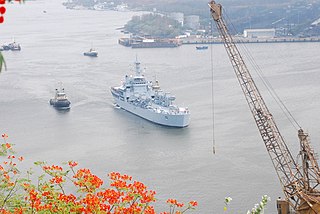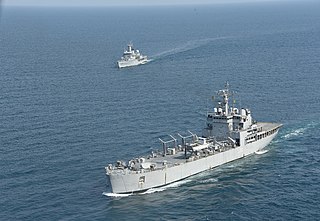
The Indian Navy is the maritime branch of the Indian Armed Forces. The President of India is the Supreme Commander of the Indian Navy. The Chief of Naval Staff, a four-star admiral, commands the navy. As a blue-water navy, it operates significantly in the Persian Gulf Region, the Horn of Africa, the Strait of Malacca, and routinely conducts anti-piracy operations and partners with other navies in the region. It also conducts routine two to three month-long deployments in the South and East China seas as well as the western Mediterranean sea simultaneously.

Operation Trident was an offensive operation launched by the Indian Navy on Pakistan's port city of Karachi during the Indo-Pakistani War of 1971. Operation Trident saw the first use of anti-ship missiles in combat in the region. The operation was conducted on the night of 4–5 December and inflicted heavy damage on Pakistani vessels and facilities. While India suffered no losses, Pakistan lost a minesweeper, a destroyer, a cargo vessel carrying ammunition, and fuel storage tanks in Karachi. Another destroyer was also badly damaged and eventually scrapped. India celebrates its Navy Day annually on 4 December to mark this operation. Trident was followed up by Operation Python three days later.
INS Shardul was a Kumbhir-class tank landing ship of the Indian Navy.

INS Jalashwa is an amphibious transport dock currently in service with the Indian Navy. Formerly USS Trenton, she, along with six Sikorsky SH-3 Sea King helicopters were procured from the United States by India for a total of US$90 million in 2005. She was commissioned on 22 June 2007. INS Jalashwa is the only Indian naval ship to be acquired from the United States. She is based in Visakhapatnam under the Eastern Naval Command.

Shardul-class landing ships are large amphibious warfare vessels built at Garden Reach Shipbuilders and Engineers for the Indian Navy. They are an evolution of the Magar-class amphibious landing ships.

INS Airavat is the third Shardul-class amphibious warfare vessel of the Indian Navy.

The Magar-class landing ships are amphibious warfare vessels of the Indian Navy, currently in active service. Only two ships of the class were designed and built by Hindustan Shipyard Limited, with fitting completed at Garden Reach Shipbuilders and Engineers.
The following ships of the Indian Navy have been named INS Kesari:

Kumbhir-class landing ships are medium amphibious warfare vessels of the Indian Navy.
INS Sharabh was a Kumbhir-class tank landing ship of the Indian Navy

INS Shardul is the lead ship of the Shardul-class amphibious warfare vessels of the Indian Navy. On 3 October 2008, Shardul was affiliated to the 5 Armoured Regiment of the Indian Army in an on-board ceremony, at the Mumbai Naval Base.

INS Kesari is a Shardul-class tank landing ship of the Indian Navy.
INS Ghorpad was a Kumbhir-class tank landing ship of the Indian Navy.

INS Cheetah is a Kumbhir-class tank landing ship of the Indian Navy.
The procurement of Landing Platform Docks (LPD) by the Indian Navy, formerly known as the "Multi-Role Support Vessel Program" (MRSV) - is an initiative of the Indian Navy to procure a series of landing platform docks, specific vessels dedicated to amphibious warfare, as part of the service's strategy to augment its capabilities of amphibious warfare, disaster-response, humanitarian assistance and auxiliary duties.
INS Batti Malv (T67) is the 3rd ship of the Bangaram-class patrol vessels of the Indian Navy, designed for interdiction against fast moving surface vessels and for search-and-rescue operations in coastal areas and in the exclusive economic zone. Named after the Battimalv Island in Nicobar, the vessel was designed and built by Garden Reach Shipbuilders and Engineers. The diesel generators on board are supplied by Cummins India. The electronic equipment on board including satellite communication and global positioning systems is from Bharat Electronics Limited, ECIL and Hindustan Aeronautics Limited.









